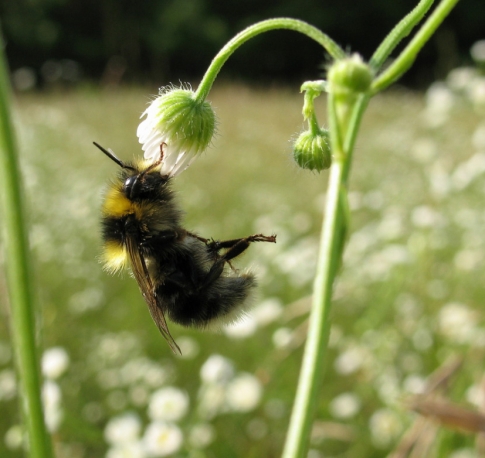News
2013-06-06
Bees in a high voltage ecosystem !
A conference on bees in Brussels
On June the 6th 2013, the conference "The bee, an indicator of ecosystems" was held at the Museum of Natural History in Brussels.
Organized by the Museum, the NGO 'Nature et Progrès' and the Federal Public Health Service, Food Chain Safety and Environment, the day ended by the following five speeches :
1. Wild bees : populations monitoring and European pollinisators monitoring program (Denis Michez)
2. The bee as sentinel of industrial, phytosanitary and veterinary practices in the « Grand Ouest » (France) (Monique L'Hostis)
3. Health indicators of bee colonies (Cyril Vidau)
4. Contamination of hives : the telling example of systemic insecticides in plants, pollen, nectar, and bees (Jean- Marc Bonmatin)
5. Bees and contaminants : decision in the context of scientific uncertainty (Laura Maxim)
Honeybee evolutions and insecticides
The informations gathered through the various interventions were specifically related to the evolution of populations of honeybees and the scientifically proven destructive role of insecticides used in agro-ecosystems. Analyses are quite expensive and we still don't have enough studies to make clear and quantified links between the use of many insecticides and their effects (some of them, though widespread, are nearly 10,000 times more toxic than DDT) and the observed mortality throughout the whole Europe, United-States and Southern America.
To introduce the talks, Denis Michez -University of Mons- drew an overview of the evolution of the diversity of wild bees in Europe, resulting from the research program STEP (« Status and Trends of European Pollinators »). Wild bees come from a very diversified group of six families , 47 genera, 1951 species (see http://westpalbees.myspecies.info ), but their main trend is a decline. For example, 19% of bumblebee species are endangered, 26 % are decreasing, 36 % are stable and 10% are growing (the last 9 % a too less known). In Belgium, out of the 380 species of wild bees reported in 1993, one third is regressing, a second third is stable and 13 more percent in expansion (the remaining species being insufficiently documented).

Loss of diversity and the role of the LIFE ELIA
All the possible causes of loss of diversity of the Apoidea fauna proposed by D. Michez may potentially be reduced by the LIFE ELIA except the use of insecticides :
- Rarefaction and fragmentation of habitats. The general idea of ELIA LIFE aims to develop a network of natural habitats by the application of the most appropriate management measures, or the restoration of some of them.
- Rarefaction of Legumes (Fabaceae). The importance of this family of plant as nectar resource for pollinators, as well as food plants for herbivorous insects (caterpillars) is well known. Therefore, we planned to integrate these species within seed mixtures (eg trefoil, clovers, wild alfalfa ... ) for the action "Creating mesotrophic flower meadows" (action C7).
- Rarefaction of hay meadows and grassland of high biological value. Such habitat of high biological interest are already present in some places under power lines and will be managed as such in the context of the action "Creation or restoration of bogs, heaths and dry meadows" (action C3) while, in other cases, we want to improve the diversity of banalized meadows by applying late mowing with hay export as described for the action "Infrastructure installation for mowing and grazing" (action C6)
- Rarefection of field-associated flora. In this case too, it is planned to include these species within seed mixtures for the action "Creating mesotrophic flower meadows" (action C7).
- "Cleaning" roadsides . This example meets very well the general idea of the LIFE project, integrating new practices of vegetation maintenance operators of the main web infrastructures (roads , waterways, pipelines , HT network , ... )
LIFE ELIA actions
Some of our actions (C3, C6 and C7) might counteract some factors of bee rarefaction, but there is more. Along with the diversification of flora, thousands of fruit trees will be planted as orchards (action C2) and within tiered edges (action C1), in addition to a dozen species of melliferous shrubs that will complement the species composition in forest corridors. Moreover, the edges which will be restored by selective gridling of trees will be enriched in standing dead wood, offering various nesting and hibernating sites for insects living in deadwood.
To conclude, even if the LIFE ELIA does not specifically relate to the status of populations of wild bees or honeybees, a real challenge for biodiversity conservation will take place along power lines network of ELIA, RTE and other operators which our project will encounter, through appropriate management of open habitats inside forests.
In all likelihood, developing habitats favorable to pollinators inside forest areas, i.e. not directly subjected to insecticides, offers quality floral resources for this endangered wildlife.


